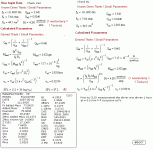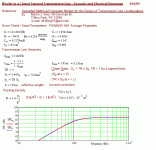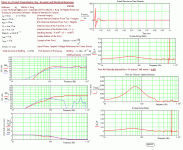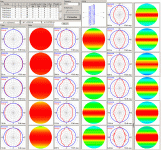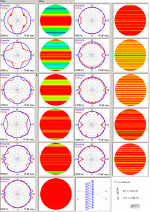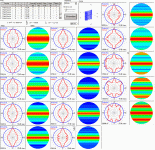We may have taken discussion about my lines as far as it can go...
Vance's book covered the one "basic" that I needed that was not covered anywhere else, which was how much insulation to put in a sealed box.
Basic though it is, no other more complicated book thought that was important.
As to Dave, he seems knowedgeable and a nice guy, other than that, I don't know him. I do know some other line array builders that I respect who do not agree with some things he says. No offense Dave; we can all find people to agree with us or disagree with us. In fact we can probably find passages in the Bible that agree with us.
You guys don't all have to come to Dave and Martin's defense. I haven't maligned them.
I haven't maligned them.
Maybe we've taken this discussion on my line arrays about as far as its going to go.
Kind regards all,
Zarathu
(whose real name is Eric J. Uberseder, and whose age in 3 weeks is 58)😱
Vance's book covered the one "basic" that I needed that was not covered anywhere else, which was how much insulation to put in a sealed box.

Basic though it is, no other more complicated book thought that was important.
As to Dave, he seems knowedgeable and a nice guy, other than that, I don't know him. I do know some other line array builders that I respect who do not agree with some things he says. No offense Dave; we can all find people to agree with us or disagree with us. In fact we can probably find passages in the Bible that agree with us.
You guys don't all have to come to Dave and Martin's defense.
 I haven't maligned them.
I haven't maligned them.Maybe we've taken this discussion on my line arrays about as far as its going to go.

Kind regards all,
Zarathu
(whose real name is Eric J. Uberseder, and whose age in 3 weeks is 58)😱
Maybe its time to move on......
This forum gets so touchy so quickly.
You can't say anything without people jumping down your throat, because they think you maligned them.
I have opinions. You can have opinions. My opinions don't have to be your opinions.
Why can't we both have opinions that are different without people getting all wired about it?
You know, not all forums are this hot wired. Just as I thought I was getting to know you guys, I say something offensive, and I don't even have a clue what it is.
I think its time to leave you all to your TL's or what ever it is that set you all off, and move on.
Zarathu
This forum gets so touchy so quickly.
You can't say anything without people jumping down your throat, because they think you maligned them.
I have opinions. You can have opinions. My opinions don't have to be your opinions.
Why can't we both have opinions that are different without people getting all wired about it?
You know, not all forums are this hot wired. Just as I thought I was getting to know you guys, I say something offensive, and I don't even have a clue what it is.
I think its time to leave you all to your TL's or what ever it is that set you all off, and move on.
Zarathu
Scott,
I'm too old to be keeping a running log of who is into what kind of stuff. I can't remember any post where you talked about horns etc.
Sorry, I don't pay that close attention to what other people are into.
Zarathu
I'm too old to be keeping a running log of who is into what kind of stuff. I can't remember any post where you talked about horns etc.
Sorry, I don't pay that close attention to what other people are into.
Zarathu
It was the end of my post in the middle of the last page. Give me an Altec VOTT and I'm a happy camper. 🙂 I really like TLs too, but these just edge them out. That-said, partnered with TL woofers, you're in real business...
Maybe its that you came into this thread with a 'my speakers are the best and nothing beats them' attitude. When people said they preferred other types of speaker you replied' I don't care as I like them'. You then stated various references as to how you came to build your speakers, and when people questioned your design choices you chose to ignore them, or chose to believe the stuff that supports your 'mine are best ' theory and dismiss the rest.
Personally I don't care either way, you just seem to be in this thread to boast about how many drivers and watts you have and tell everyone how you don't care about their speakers / opinions as they're listening to 'little apples' against your big balls 'watermelons'
I find it funny that your sig reads:
""The will to disbelieve is the greatest deterrent to wider horizons.""
as you're clearly showing a will to disbelieve here.
Rob.
Personally I don't care either way, you just seem to be in this thread to boast about how many drivers and watts you have and tell everyone how you don't care about their speakers / opinions as they're listening to 'little apples' against your big balls 'watermelons'
I find it funny that your sig reads:
""The will to disbelieve is the greatest deterrent to wider horizons.""
as you're clearly showing a will to disbelieve here.
Rob.
Line arrays in HT.
I found this thread very interesting especially because of the line array discussion between Zarathu and Planet10. I'm planning my own dedicated HT and will build a full 7.1 set of line arrays all around.
I'm planning on line arrays because of their very large sweet spot and ability to reach reference levels without strain.
My attempt will be more frugal like but I would like to incorporate good design as much as possible. I'll be using 4" mids (Pioneer NSBs) and ApexJR tweets. They will be around 8 feet tall with full coverage on both the mids and tweeters. I'm aiming in going fully active.
I'm keeping Zarathu's design in mind and might consider somethings similar. Having said all that I wonder if Planet10 or Scottmoose could offer some advice regarding TL and individual enclosures for each 4" mid.
My aim if possible is to have a 2 way design that will play low. Could this be accomplished with a TL design similar to Zarathu's. The NSBs are cheap speakers that won't play very low. I would at least want them to play down to the 80hz so that they can easily be crossed to a pair of subwoofer arrays made up of 4 18" woofers in each.
Any ideas about good array design incorporating TL or 3d spiral horn ?
No intention to highjack this thread and would happily create another threat to continue this discussion in case you like me to. But I hope this relates to the topic since ultimate HT is for me line arrays (opinion only). Would be interesting to see if some of the experts here would recommend full floor to ceiling line arrays for the surrounds or if half height built as a dipole would be better.
Cheers,
Exipnos
I found this thread very interesting especially because of the line array discussion between Zarathu and Planet10. I'm planning my own dedicated HT and will build a full 7.1 set of line arrays all around.
I'm planning on line arrays because of their very large sweet spot and ability to reach reference levels without strain.
My attempt will be more frugal like but I would like to incorporate good design as much as possible. I'll be using 4" mids (Pioneer NSBs) and ApexJR tweets. They will be around 8 feet tall with full coverage on both the mids and tweeters. I'm aiming in going fully active.
I'm keeping Zarathu's design in mind and might consider somethings similar. Having said all that I wonder if Planet10 or Scottmoose could offer some advice regarding TL and individual enclosures for each 4" mid.
My aim if possible is to have a 2 way design that will play low. Could this be accomplished with a TL design similar to Zarathu's. The NSBs are cheap speakers that won't play very low. I would at least want them to play down to the 80hz so that they can easily be crossed to a pair of subwoofer arrays made up of 4 18" woofers in each.
Any ideas about good array design incorporating TL or 3d spiral horn ?
No intention to highjack this thread and would happily create another threat to continue this discussion in case you like me to. But I hope this relates to the topic since ultimate HT is for me line arrays (opinion only). Would be interesting to see if some of the experts here would recommend full floor to ceiling line arrays for the surrounds or if half height built as a dipole would be better.
Cheers,
Exipnos
Originally posted by exipnos The NSBs are cheap speakers that won't play very low. I would at least want them to play down to the 80hz so that they can easily be crossed to a pair of subwoofer arrays made up of 4 18" woofers in each.
Big room or you just want LOTs of bass? :^)
Eric's goal with his 1/2 wave aperiodic TL was to end up with an enclosure that completely consumed the back wave. Yours would be to try to use the TL to get extra extension to reach down to the woofers ... can you point us to the specs?
dave
I found two sets of specs out on the net.
Re 7.45 [ê ]
Fs 106.04 [Hz]
F1 81.75 [Hz]
F2 137.25 [Hz]
Zm 50.34 [ê]
D 0.00 [mm]
Qms 5.23
Qes 0.91
Qts 0.77
Bl 0.00 [N/A]
L1K 0.62 [mH]
L10K 0.23 [mH]
Ms 0.00 [g]
Vas 0.00 [l]
dBSpl 0.00 [dB]
Cms 0.00 [mm/N]
Ma 0.00 [g]
FsMa 0.00 [Hz]
and the second
Fs 104 Hz
Qms 5.021
Vas 3.27 L
Cms 0.721
Mms 3.2 g
Rms 0.421 kg/s
Xmax 1 mm
P-Diam 84.85 mm
P-Vd 0.00565 L
Qes 0.915
Re 6.9 ohms
Le 0.58 mH
Z 8.3 ohms
BL 4.0 Tm
Qts 0.774
1-watt SPL/m 88 dB
Re 7.45 [ê ]
Fs 106.04 [Hz]
F1 81.75 [Hz]
F2 137.25 [Hz]
Zm 50.34 [ê]
D 0.00 [mm]
Qms 5.23
Qes 0.91
Qts 0.77
Bl 0.00 [N/A]
L1K 0.62 [mH]
L10K 0.23 [mH]
Ms 0.00 [g]
Vas 0.00 [l]
dBSpl 0.00 [dB]
Cms 0.00 [mm/N]
Ma 0.00 [g]
FsMa 0.00 [Hz]
and the second
Fs 104 Hz
Qms 5.021
Vas 3.27 L
Cms 0.721
Mms 3.2 g
Rms 0.421 kg/s
Xmax 1 mm
P-Diam 84.85 mm
P-Vd 0.00565 L
Qes 0.915
Re 6.9 ohms
Le 0.58 mH
Z 8.3 ohms
BL 4.0 Tm
Qts 0.774
1-watt SPL/m 88 dB
Attachments
Two options in Line array designs
How cheap can you go when you design an array? If you read the literature it would seem that you can’t go cheaper than about 3000 to 5000 dollars.
But this is not really true.
Lets first look at the electronics. You need a pre-amp, three power amps, a 3 way electronic crossover, a sound level meter, and possibly a constant Q minimum stereo 2/3 octave equalizer.
On eBay you can fine a Kenwood c-1 pre-amp for about $30, three Kenwood KM-106 150 watt/ch amps for $60 each, a Rane crossover for about $130, and sound level meter for about $40. If you want to throw in the equalizer, about $130.
So……the hardware will cost you about $360 without the equalizer, and about $500 with it.
Now….the speakers. We’re not going to include the cost of the cabinets. That’s up to you and could cost from less than $300 to way way more.
But speaker wise there are two basic directions to go:
1. 24 6.5 inch Dayton 160b’s at $13 each for $312 total
2. 12 Dayton Planars at $27.75 each for $333.
3. two sub woofers: MADISOUND NHT10 10" 12 ohm Subwoofer= $55 each X 2 = $110
The total cost minus the cabinets on this system would be: about $1200 + cabinets.
Or
1. 64 Dayton ND20FA-6’s at about $3.50 each = $224
2. 34 - ALL Electronic CORP SK-480’s at 5.50 EACH= $187
3. two sub woofers: MADISON NHT10 10" 12 ohm Subwoofer= $55 each X 2 = $110
This total cost would be $881 + cabinets.
Zarathu
How cheap can you go when you design an array? If you read the literature it would seem that you can’t go cheaper than about 3000 to 5000 dollars.
But this is not really true.
Lets first look at the electronics. You need a pre-amp, three power amps, a 3 way electronic crossover, a sound level meter, and possibly a constant Q minimum stereo 2/3 octave equalizer.
On eBay you can fine a Kenwood c-1 pre-amp for about $30, three Kenwood KM-106 150 watt/ch amps for $60 each, a Rane crossover for about $130, and sound level meter for about $40. If you want to throw in the equalizer, about $130.
So……the hardware will cost you about $360 without the equalizer, and about $500 with it.
Now….the speakers. We’re not going to include the cost of the cabinets. That’s up to you and could cost from less than $300 to way way more.
But speaker wise there are two basic directions to go:
1. 24 6.5 inch Dayton 160b’s at $13 each for $312 total
2. 12 Dayton Planars at $27.75 each for $333.
3. two sub woofers: MADISOUND NHT10 10" 12 ohm Subwoofer= $55 each X 2 = $110
The total cost minus the cabinets on this system would be: about $1200 + cabinets.
Or
1. 64 Dayton ND20FA-6’s at about $3.50 each = $224
2. 34 - ALL Electronic CORP SK-480’s at 5.50 EACH= $187
3. two sub woofers: MADISON NHT10 10" 12 ohm Subwoofer= $55 each X 2 = $110
This total cost would be $881 + cabinets.
Zarathu
The Calipso Line Array Design Requirements
The Calipso Line Array
The Calipso Array has been developed on a model that includes the following essential characteristics:
1. Three-Way design.
In point source speaker systems, a two way design is often considered to be an inadequate compromise. Much of audio has gone to two way designs with a single sub woofer. Vance Dickason in his 6th Edition of The Loudspeaker Cookbook has indicated that the use of dual woofers that are capable of subwoofer frequencies produces a significantly better sound image than a subwoofer. In this design a large 12 inch high mm Xmax woofer is used with each side, and it crosses to the mid ranges at about 165hz. While mine are not currently in the correct size box, the correct size is a 6-8 cu ft vented box.
2. No Crossover in the most sensitive areas of human hearing.
Rod Elliot at Southwest Audio(http://sound.westhost.com/bi-amp2.htm ) makes the case better than I:
“It is not at all uncommon to see systems where the crossover frequency is set right in the middle of what I call the "intelligence band". This is the range of frequencies from 300Hz to 3600Hz, and is extremely important from a psycho-acoustic point of view.
“It is no accident that this is the range of the telephone system (and has been for many years). If we are only to hear a limited range, then this band of frequencies is by far the most important. Just from this we can recognize a person's voice, which musical instrument is being played (even bass instruments!), and - more importantly - what is being said. It contains nearly all the "intelligence" of the sound, which is to say that if this band is "corrupted", intelligibility is greatly reduced.
“So why do speaker manufacturers insist on placing their crossover frequencies within this band of frequencies? The public address (PA) systems used by many rock bands are a case in point - how often does one find that the vocals are completely unintelligible? Mind you, it may also be the case that the band's lyrics just don't make sense, but that's another story altogether.
“Often this occurs because the system is so loud that the amplifiers are clipping badly, but even at lower levels it is quite common. Place a common-or-garden crossover filter right in the middle of the "intelligence band" and this is exactly what will (and does) happen. With phase aberrations and cancellations, this most important frequency range becomes muddied and indistinct causing loss of intelligibility - not only on voice, but instruments as well.
“The effect is also noticeable with some hi-fi speaker systems, except that it usually less pronounced, and it is far less likely that the amplifier will be driven to clipping. Reviewers will often say of a speaker that the vocals seem veiled, or that there is noticeable coloration of either male or female vocals. These effects are often caused by the effects of phase shift around the crossover frequency, coupled with the fact that the crossover frequency falls right in the middle of the intelligence band.”
What Rod says is very hard to do with point source speakers, but with line arrays, the midrange speakers are often loafing along, and if they have the range, pulling the wagon as a group of horses, they can do the job admirably.
3. Use Electrical Crossovers.
Again, passive crossovers are a DATED TECHNOLOGY. Passive’s introduce so much negative into the sound that they should not be there. And the cost of a top of the line passive cross(with the increased cost of copper) and a electronic is almost the same. Read Rod Elliot’s papers on Bi-Amplification and electronic crossovers at http://sound.westhost.com
The only reason for not using them is that you’ve spent years learning how to design them and you aren’t giving that up, or you are in the business of selling speakers and you aren’t willing to sell amps and crossovers too.
4. Separate the midrange speakers from all other influences.
Bad coloration of sound, in my opinion, is caused by other sound that the direct radiation coming through the speakers. This means that you have to eliminate ANYTHING that goes out the back of the speaker, and anything that might be in the box behind the speaker from coming forward through the speaker again and muddying the sound clarity. (Some people don’t believe that this is impactive.)
To do this, this design uses SEALED separate 4 inch PVC tubes for each of the 34 midrange/mid bass speakers. Each tube is physically separates from its peers by ¾ inch of open air space.
On page 35 of the Dickason 6th Edition Loudspeaker Cookbook, there is an empirical study on the efficiency of various stuffing materials. The greatest attenuation was determined to be at the 4 lb/cu ft density level. Frequencies within the range of the mid/midbass speaker are right within the range of attenuation. Only by using tubes can the appropriate density be achieved, since the insulation can be stuff tightly against the walls of the tube and not push up against the speaker itself. The part closest to the speaker is protected by a layer of sheet pillowfill from the fiberglass threads that might otherwise get into the voice coil.
Additionally there are some benefits of the tube’s inability to make odd ordered harmonics, or odd ordered harmonic distortion, but that will not be addressed here.
This design is labor intense but it helps make the 3 inch midrange speaker process viable.
5. Keep the cost down below $1400 for the speakers, and the required electronics.
6. Keep Comb distortion in the mid and high frequency drivers below Griffin minimums, and use dome tweeter SOUND rather than ribbons or planars, for their flatter frequency response.
The only dome tweeters that I know which have a center to center distance small enough, and at the same time can be crossed low enough, are Dayton Neo ND20FA’s. These have their flanges cut so that the c-to-c is .9 inch, and the comb filter distortion doesn’t start until more than half way into the last octave, or more than 15,000Khz.
Now you know some of the design requirements.
Zarathu
The Calipso Line Array
The Calipso Array has been developed on a model that includes the following essential characteristics:
1. Three-Way design.
In point source speaker systems, a two way design is often considered to be an inadequate compromise. Much of audio has gone to two way designs with a single sub woofer. Vance Dickason in his 6th Edition of The Loudspeaker Cookbook has indicated that the use of dual woofers that are capable of subwoofer frequencies produces a significantly better sound image than a subwoofer. In this design a large 12 inch high mm Xmax woofer is used with each side, and it crosses to the mid ranges at about 165hz. While mine are not currently in the correct size box, the correct size is a 6-8 cu ft vented box.
2. No Crossover in the most sensitive areas of human hearing.
Rod Elliot at Southwest Audio(http://sound.westhost.com/bi-amp2.htm ) makes the case better than I:
“It is not at all uncommon to see systems where the crossover frequency is set right in the middle of what I call the "intelligence band". This is the range of frequencies from 300Hz to 3600Hz, and is extremely important from a psycho-acoustic point of view.
“It is no accident that this is the range of the telephone system (and has been for many years). If we are only to hear a limited range, then this band of frequencies is by far the most important. Just from this we can recognize a person's voice, which musical instrument is being played (even bass instruments!), and - more importantly - what is being said. It contains nearly all the "intelligence" of the sound, which is to say that if this band is "corrupted", intelligibility is greatly reduced.
“So why do speaker manufacturers insist on placing their crossover frequencies within this band of frequencies? The public address (PA) systems used by many rock bands are a case in point - how often does one find that the vocals are completely unintelligible? Mind you, it may also be the case that the band's lyrics just don't make sense, but that's another story altogether.
“Often this occurs because the system is so loud that the amplifiers are clipping badly, but even at lower levels it is quite common. Place a common-or-garden crossover filter right in the middle of the "intelligence band" and this is exactly what will (and does) happen. With phase aberrations and cancellations, this most important frequency range becomes muddied and indistinct causing loss of intelligibility - not only on voice, but instruments as well.
“The effect is also noticeable with some hi-fi speaker systems, except that it usually less pronounced, and it is far less likely that the amplifier will be driven to clipping. Reviewers will often say of a speaker that the vocals seem veiled, or that there is noticeable coloration of either male or female vocals. These effects are often caused by the effects of phase shift around the crossover frequency, coupled with the fact that the crossover frequency falls right in the middle of the intelligence band.”
What Rod says is very hard to do with point source speakers, but with line arrays, the midrange speakers are often loafing along, and if they have the range, pulling the wagon as a group of horses, they can do the job admirably.
3. Use Electrical Crossovers.
Again, passive crossovers are a DATED TECHNOLOGY. Passive’s introduce so much negative into the sound that they should not be there. And the cost of a top of the line passive cross(with the increased cost of copper) and a electronic is almost the same. Read Rod Elliot’s papers on Bi-Amplification and electronic crossovers at http://sound.westhost.com
The only reason for not using them is that you’ve spent years learning how to design them and you aren’t giving that up, or you are in the business of selling speakers and you aren’t willing to sell amps and crossovers too.
4. Separate the midrange speakers from all other influences.
Bad coloration of sound, in my opinion, is caused by other sound that the direct radiation coming through the speakers. This means that you have to eliminate ANYTHING that goes out the back of the speaker, and anything that might be in the box behind the speaker from coming forward through the speaker again and muddying the sound clarity. (Some people don’t believe that this is impactive.)
To do this, this design uses SEALED separate 4 inch PVC tubes for each of the 34 midrange/mid bass speakers. Each tube is physically separates from its peers by ¾ inch of open air space.
On page 35 of the Dickason 6th Edition Loudspeaker Cookbook, there is an empirical study on the efficiency of various stuffing materials. The greatest attenuation was determined to be at the 4 lb/cu ft density level. Frequencies within the range of the mid/midbass speaker are right within the range of attenuation. Only by using tubes can the appropriate density be achieved, since the insulation can be stuff tightly against the walls of the tube and not push up against the speaker itself. The part closest to the speaker is protected by a layer of sheet pillowfill from the fiberglass threads that might otherwise get into the voice coil.
Additionally there are some benefits of the tube’s inability to make odd ordered harmonics, or odd ordered harmonic distortion, but that will not be addressed here.
This design is labor intense but it helps make the 3 inch midrange speaker process viable.
5. Keep the cost down below $1400 for the speakers, and the required electronics.
6. Keep Comb distortion in the mid and high frequency drivers below Griffin minimums, and use dome tweeter SOUND rather than ribbons or planars, for their flatter frequency response.
The only dome tweeters that I know which have a center to center distance small enough, and at the same time can be crossed low enough, are Dayton Neo ND20FA’s. These have their flanges cut so that the c-to-c is .9 inch, and the comb filter distortion doesn’t start until more than half way into the last octave, or more than 15,000Khz.
Now you know some of the design requirements.
Zarathu
If you are just reading this thread by going to the end, we moved the design description of the Calipso Line Array to the beginning so there could be some cohesion regarding what was talked about.
Its now the first post.
Thanks
Zarathu
Its now the first post.
Thanks
Zarathu
Hi guys
I've had a look at the NSBs in MathCad and frankly, they're not going to suit open-ended TL loading at all well. A closed line will do a decent enough job, but neither open or closed will get you anywhere near 80Hz, unless you're planning on using Roger Russel levels of Eq -given the sheer quantity of NSBs you must be planning for an 8ft tall enclosure (about 20?), that might be worth exploring as 80Hz isn't unreasonable. FWIW, I'd make life easy for myself and stick them into a sealed box, possibly with some mild aperiodic venting to recuce the impedence peak a bit.
Scott
I've had a look at the NSBs in MathCad and frankly, they're not going to suit open-ended TL loading at all well. A closed line will do a decent enough job, but neither open or closed will get you anywhere near 80Hz, unless you're planning on using Roger Russel levels of Eq -given the sheer quantity of NSBs you must be planning for an 8ft tall enclosure (about 20?), that might be worth exploring as 80Hz isn't unreasonable. FWIW, I'd make life easy for myself and stick them into a sealed box, possibly with some mild aperiodic venting to recuce the impedence peak a bit.
Scott
stick them into a sealed box, possibly with some mild aperiodic venting to reduce the impedance peak a bit.
Agree and this can be extended to a small volume MLTL and for array application, but it seems that nothing is gained with a MLTQWT or classic TL approach.
b
1(3)
Attachments
Exipnos,
First FYI, look at the polar pictures and draw your own conclusions…you may find differences to what’s earlier claimed in the tread above.
For surrounds I rec. you to try 5 element NSBs Bessel arrays in closed boxes, used in pairs, two or more, preferably 4 at each side placed differently for both Ls and Rs lateral use (solves the impedance problem).
Place them at the floor close to the sidewalls, aiming at the ceiling, hide if possible, they are real omni in dispersion and there is no need for any extra tweeters.
There is no gain using full-length arrays, as Ls and Rs mostly are placed at the rear azimuth of ‘cone of confusion’ and 5 elements Bessel arrays work also well as rear placed surrounds.
But for this later mentioned purpose, I prefer 25 elements Bessel arrays in the rear corners or one placed as a rear center, horizontally placed and almost covering the whole length of the wall at the floor or the at the ceiling level.
My opinion is also, that the use of besselarray types for all surrounds sounds guarantees a more natural experience when music is performed and when a DVD movie is played the only way to hear the location of any bessel surround speaker separately is when you place an ear within a feet or at max two, in front of a driver baffle.
I have never heard complaints from anybody attending a DVD movie session when using Bessel arrays for all surrounds in a HT set-up except for the frontal speakers.
However, I have not heard, (all my friends agree), a HT setup in a normal living room, large or a small, with conventional speakers that hasn’t got complaints from all attendants but the one who’s is lucky enough to sit in the sweet spot.
When using short Bessel arrays for surrounds, this never seems to occur.
b
1(5)
I'm planning on line arrays because of their very large sweet spot and ability to reach reference levels without strain…..But I hope this relates to the topic since ultimate HT is for me line arrays (opinion only). Would be interesting to see if some of the experts here would recommend full floor to ceiling line arrays for the surrounds or if half height built as a dipole would be better…
First FYI, look at the polar pictures and draw your own conclusions…you may find differences to what’s earlier claimed in the tread above.
For surrounds I rec. you to try 5 element NSBs Bessel arrays in closed boxes, used in pairs, two or more, preferably 4 at each side placed differently for both Ls and Rs lateral use (solves the impedance problem).
Place them at the floor close to the sidewalls, aiming at the ceiling, hide if possible, they are real omni in dispersion and there is no need for any extra tweeters.
There is no gain using full-length arrays, as Ls and Rs mostly are placed at the rear azimuth of ‘cone of confusion’ and 5 elements Bessel arrays work also well as rear placed surrounds.
But for this later mentioned purpose, I prefer 25 elements Bessel arrays in the rear corners or one placed as a rear center, horizontally placed and almost covering the whole length of the wall at the floor or the at the ceiling level.
My opinion is also, that the use of besselarray types for all surrounds sounds guarantees a more natural experience when music is performed and when a DVD movie is played the only way to hear the location of any bessel surround speaker separately is when you place an ear within a feet or at max two, in front of a driver baffle.
I have never heard complaints from anybody attending a DVD movie session when using Bessel arrays for all surrounds in a HT set-up except for the frontal speakers.
However, I have not heard, (all my friends agree), a HT setup in a normal living room, large or a small, with conventional speakers that hasn’t got complaints from all attendants but the one who’s is lucky enough to sit in the sweet spot.
When using short Bessel arrays for surrounds, this never seems to occur.
b
1(5)
Attachments
- Home
- Loudspeakers
- Multi-Way
- Zarathu's Line Arrays
